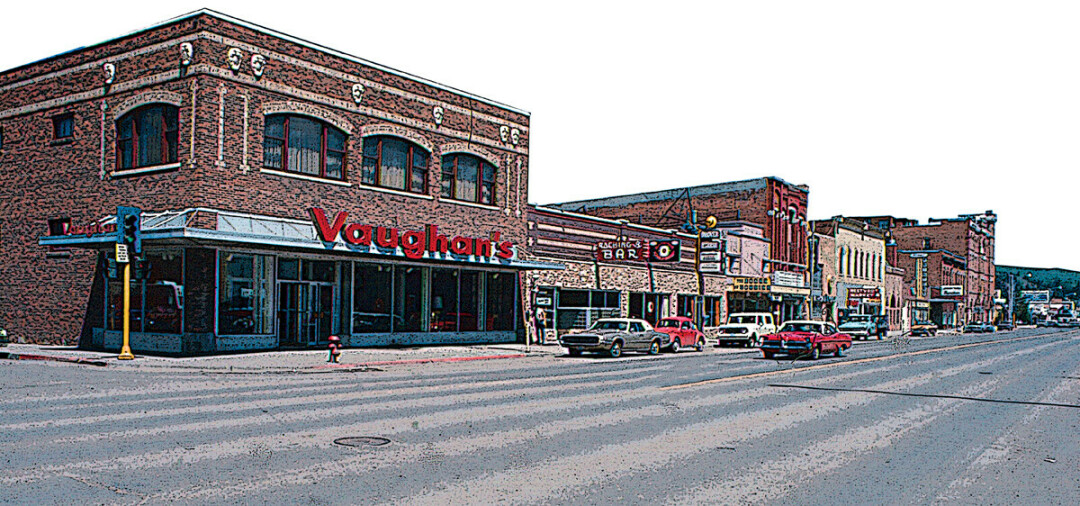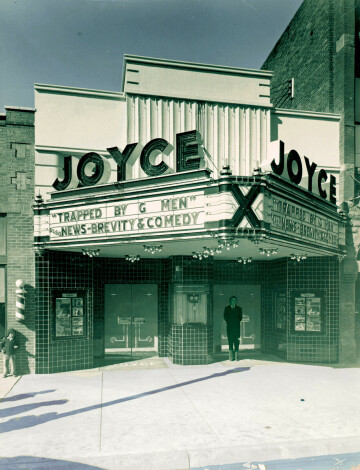The Block That Was Rocked
Rachel Phillips | Monday Mar. 1st, 2021

Shortly after 8:00 am on March 5, 2009, a natural gas explosion rocked downtown Bozeman. The initial blast and resulting fire destroyed and damaged several historic buildings on the north side of Main Street, just east of Bozeman Avenue. Tragically, one person was killed.
Several Bozeman businesses were profoundly affected by this event, including the Rocky Mountain Rug Gallery, Rocking R Bar, Boodles restaurant, Montana Trails Gallery, Lilly Lu’s children’s clothing, American Legion, Starky’s restaurant, and the Great Rocky Mountain Toy Company. In the aftermath of the blaze, curiosity about the area’s history was ignited. Interestingly, research reveals that the 2009 incident was not the first traumatic event to shake up the 200 block of East Main Street.
“Bozeman Blazes” was the headline on January 1, 1888, in the Bozeman Daily Chronicle. “Nearly an entire block of business houses laid in ashes. Stocks of merchandise badly damaged.” The fire occurred on December 27, 1887, and ironically destroyed buildings in approximately the same area as that on March 5, 2009. The newspaper commented that “the fire department was at the scene of conflagration with their usual promptness.” Within a week one merchant, Lewis Sperling, had reopened his store in another block and August Gottschalk of the Montana Armory “is temporarily located in the building one door east of the Courier block.” Eventually, new brick structures and businesses sprouted in the empty lots.
One building that survived the fire of 1887 was the brick LaClede Hotel (northeast corner of Main St. and Bozeman Ave.). Structures to the east—a restaurant, a grocer and meat packing facility, a tailor and milliner store (hat shop) were gone. The paper reported the fire as “the danger which threatened not only the destruction of the entire row of wooden buildings in the block, but which also seriously imperiled the brick buildings…” The paper goes on to report, “The 200-foot gap made by the fire fiend…will be filled up with substantial brick structures next summer.” It actually took a little longer, but by the 1890s, the gap had been filled with several saloons and a millinery store.
There had to be a building known as the Nevitt Block next to the LaClede, since the newspaper states that the fire started in Mr. Nevitt’s wooden store. Mr. Nevitt later built another building to the west of Bozeman Avenue. The four addresses next to the LaClede (209-215 E. Main or Rocking R Bar and Boodles in 2009) were once known as the Ellis, Davis and Sperling Block.
Mr. Sperling came to the Gallatin Valley in 1866 as a Polish Jewish immigrant. He was the consummate merchandiser, having pedaled his wares from the East Coast to California and then into Montana. Ellis and Davis also had stores that supplied everything from “California clothes” and “Oregon blankets” to farm goods, and always advertised new merchandise, not “last year’s.”
Each of the buildings has a story to tell about the people and history of Bozeman. The LaClede Hotel anchored the block on the west, serving as a place for lodging and, of course, a saloon. In 1912, the owner of the business is listed as Chin A Ban, operating a lodging and restaurant. Another restaurant and saloon, Joe Chin’s, followed in the same location. The saloon disappeared during prohibition and a Mr. C.F. Miller operated a soft drink parlor on the corner.
By 1928, a new brick building replaced the old hotel and for nearly forty years, Montgomery Ward, the catalog and retail store, catered to Bozeman. Montgomery Ward rejected a merger with Sears in 1930, but is remembered for a 1939 Christmas promotional campaign which created Rudolph, the Red-Nosed Reindeer. Prior to becoming the Rocky Mountain Rug Gallery in 2003, Vaughan’s Furniture and Conlin’s Furniture decorated Bozeman homes from the same location.
From Bozeman’s Village Phase (1873-1883) through the Civic Phase (1884-1912), this area was a very active section of town. Money makers in the neighborhood included shops, saloons, merchants, drug stores and prostitutes. Even the alleys had small dwellings of commerce and trade.
Some of the businesses off Main Street were owned by Chinese residents and centered in an alley just north of Main Street between N. Rouse and N. Bozeman. The Chinese business owners had laundries and restaurants in the neighborhood and on both sides of Main Street. J. Maurice Jones recalled in a 1983 article that lots of people “used to live in a big two-story brick and rock building behind where Vaughn’s (Rocky Mountain Rug Gallery) is now. I don’t know how they fit so many in one building. I used to go in there when I was a small boy to buy firecrackers.” It was also rumored that people lay about, “smoked opium and went to dreamland.” The Chinese merchants sold herbs, spices, paper products, firecrackers and medicines. With the exception of a few buildings, many of the alley structures were torn down in the 1930s.
City directories show saloons dominated the cityscape at addresses 209-215 E. Main at least until 1914. At 209 E. Main, a barber business took over from a saloon and lasted for sixty years, owned first by Claude Marquis (1922-1958) and then by Arnold Diede (1959-1978). The Pickle Barrel restaurant gained a Main Street presence there in 1998. Previously, John’s Pork Chop was the eatery.
The Rocking R Bar became a Bozeman institution in the late thirties. It is said to be the longest running bar on Main Street. So saloons, in a way, made a comeback.
An early 1890s saloon owner, Walter C. Latta, rented his building at 215 E. Main from a Miss Lizzie Woods. This property eventually became Boodles restaurant but over the course of time was the B & B Café and Cowboy Café.
Miss Woods was once listed in a census as “sport” meaning a prostitute. At the time of her death in 1918 and according to historic documents, Lizzie owned the “Latta Saloon property, a rooming house on the corner of [North] Rouse and East Mendenhall in Bozeman, [and] certain vacant lots in the Imes Addition to the city of Bozeman.” In 1900, Lizzie Woods owned property free and clear at 38 East Mendenhall Street, across the alley from her Main Street property. Interestingly, the abstract for the property (215 E. Main), indicates it was owned early on by Davis and Sperling. The building that housed Boodles restaurant in 2009 represented a very colorful part of Bozeman history.
The structure occupied by the Montana Trails Gallery (219 E. Main St.) was home to a variety of businesses during its long history. In 1884, the lot sported a tailor shop with a dwelling in the rear. This original building was probably destroyed in the 1887 fire on Main Street. A new structure was built, and in 1891, a hardware and stove store moved in. Most likely an early McCay Hardware store, this business was a Bozeman Main Street fixture (at various locations) until the early 1950s. In 1895, H.B. McCay married Irene (or Irena) Frazier, daughter of Elmyra Heard Frazier. George and Elmyra Frazier were Bozeman pioneers. In the 1860s, they struck up a business partnership with John Bozeman, together building the City Hotel in 1866. In 1871, the Frazier House was built on the southeast corner of Mendenhall Street and Bozeman Avenue, a hotel which Elmyra ran by herself after the death of her husband in 1874. The hotel was running up until the 1920s.
As mentioned previously, in the early 1900s the 200 block of East Main Street was littered with saloons. The former Montana Trails Gallery building was no exception and occupied the last spot in a string of five in 1904. In about 1922, the Bozeman Storage Battery Company moved in. Selling tires, they remained in business through the late 1930s. Next, the building was transformed into the Joyce Theater, opening March 18, 1938. This modern and comfortable family theater was one of several improvements made to East Main Street in the 1930s. One of the Joyce’s first shows was “Meet the Boy Friend,” starring David Carlyle and Carol Hughes. As printed in a newspaper advertisement for the picture on March 24, 1938, children were admitted for ten cents and adults for twenty-five. One could also expect to see a color cartoon and musical in addition to the feature show. Longtime Bozeman residents recall that the Joyce Theater was the first such establishment in town to show 3D movies. Sadly, the Joyce Theater was gone by 1956.
After sitting vacant for a couple of years, 219 E. Main Street was put to use again. Perhaps taking advantage of the building’s interior layout, the Gallatin County Revival Center and later the Youth for Christ Films Theater used the space until about 1964. Between 1971 and 1994, several different shops called this building home, including Tom’s Pets & Hobbies, Kerr’s Aquatics, House of Hobbies, Nicholls Music Centre, and Canyon Crafts. Zabel Publishing Company and Montana Trails Gallery and Custom Framing opened up shop in 1994.
Lilly Lu’s, at 223 E. Main in 2009, was also sitting on rich history. City fire insurance maps suggest that in 1884 a millinery stood at this location. Research indicates the owner was Louisa Cousselle, a madam who predated Lizzie Woods. Having arrived from Helena, Cousselle mentored Kitty Warn, a young woman who went on to establish several “houses of ill repute” along Mendenhall Street. In 1885, Kitty Warn died at the age of 23 after accidently catching her clothing on fire. Louisa Cousselle herself passed away in 1886. It appears this early building was also destroyed in the Main Street fire of late December 1887.
In 1891, work was completed on the two-story, brick and stone building that would house the Odd Fellows fraternity until 1984. The contract for the brick and stonework totaled $3,445, and the woodwork cost under $5,000. The Odd Fellows fraternity (or the I.O.O.F.) began in London in about 1745 and was established in the United States by 1806. As for the organization’s history in Bozeman, W.L. Blackwell and several other townsmen met in January of 1872 to discuss the possibility of creating a lodge. Just a few days later, officers were elected and regular meetings began. As an organization, the Odd Fellows emphasized caring for their fellow men. By helping the sick and the orphaned, educating, and promoting brotherly love, the group followed their motto: “Friendship, Love and Truth.” Through the years, many businesses called the I.O.O.F. building home, including the Junque Shop antique store and the Brass & Wood furniture store. The rooms upstairs were used as meeting places for other fraternal organizations and later as office space. The Montana Ballet Company used the second floor as a dance studio until 2006, while Lilly Lu’s occupied the first floor.
It appears that the lot at 225 E. Main (the American Legion) sat empty next to the I.O.O.F. Hall for much of Bozeman’s early history. However, the alley behind was home to a couple of Chinese goods stores—the Quong Wah Lee Company and a shop owned by Yee Lee. By 1912, the Lyric Theater was located at 225 E. Main Street, just a few doors east of the future Joyce Theater (219 E. Main). Not much is known about this venue except that in 1914 it had a female proprietor, a Mrs. Ella Von Prosky. John Von Prosky (possibly a son or husband) was the musician. In 1912, J.W. Edwards owned a pool hall in the basement. Short-lived, the Lyric Theater was gone by 1922. The building was then devoted to automobile repair until the 1940s. The first occupant was Nelson Motors in 1922, followed by Bellows & Nelson machine shop, Lobdell autos, Riggs Motor Company, and Ellis Motors. An Assembly of God church came next. After the American Legion purchased the space in about 1947, an increase in membership led to the enlargement and remodel of the building. In charge of the structure’s new look was local architect Fred F. Willson. Son of Bozeman pioneer General Lester Willson, Fred designed many buildings in Gallatin County, including Willson School, the Ellen Theater, and the Baxter Hotel. The Legion held its Grand Opening on August 5, 1949.
In 1882, the building known as the Osborn (or Osborne) block was built at 229-233 E. Main. Originally established in the late 1860s, Osborn’s Drug Store was one of the first pharmaceutical businesses in Bozeman. It was initially located in a former log hotel at the northwest corner of E. Main Street and Bozeman Avenue. However, by 1884, city maps suggest that Osborn’s had relocated almost a block east to what is now 229-233 E. Main. By 1912, A.W. Orton Music was operating in the building, and Forristell Grocery was located next door. Evidence indicates that this grocery was a wooden frame structure on the eastern side of the Osborn block, where the Montana Gift Corral is located today. Forristell Cash Grocery opened in the 1890s and remained in business until the early 1940s. Its founder, James Forristell, immigrated to the United States from Dublin, Ireland, as a teenager. He worked in a grocery store until joining the army in 1875. Forristell served under General James Crook and arrived at the Little Bighorn Battlefield in time to help bury the dead. Stationed at Fort Ellis from 1879 to 1883, James Forristell eventually moved into Bozeman and established his shop. He died in 1944 at age 90. Later businesses in the Osborn block included a TV shop and Restvedt’s Meat Market. Starky’s restaurant, the Great Rocky Mountain Toy Company, and second floor apartments were heavily damaged from the fire on March 5, 2009, and the building was later removed.
Twelve years ago, when the 200 block of East Main Street in downtown Bozeman burst into flames, much was lost and buried under piles of debris. Business owners, residents and the town suffered when the historic fabric was torn apart. The buildings represented early Bozeman, the pioneering spirit, the ability to recover and part of Bozeman history. Today, obvious reminders of the 2009 natural gas explosion are gone. The gaping hole on East Main has been filled in with new structures, and several businesses that suffered damage that day continue to thrive downtown. The 200 block of East Main Street rebuilt and started a new chapter, just as it did after that first fire, 120 years before.
Ann Butterfield is the former Assistant Director at the Pioneer Museum (now the Gallatin History Museum) in Bozeman. Rachel Phillips is the Research Coordinator at the Gallatin History Museum. Ann and Rachel would like to thank Dia Johnson and Richard Brown for their invaluable research assistance.
| Tweet |
